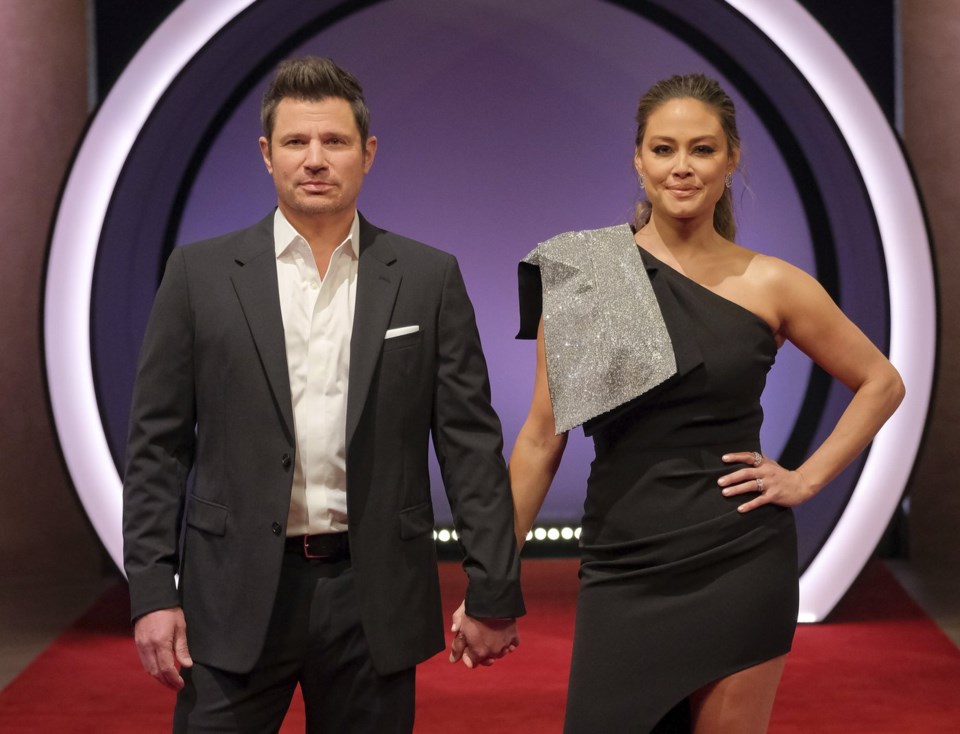NEW YORK (AP) ‚ÄĒ When a couple decided to take their relationship further on the most recent season of the moment was soundtracked with a familiar song: ‚ÄúBirds of a Feather.‚ÄĚ
It wasn‚Äôt a flash-in-the-pan musical surprise. The season was stacked with familiar needle drops ‚ÄĒ ‚ÄúWrecking Ball,‚ÄĚ ‚ÄúHī«ĪŰ≤‚,‚ÄĚ ‚ÄúInto You,‚ÄĚ ‚ÄúLose You to Love Me‚ÄĚ ‚ÄĒ a gesture away from the little-known, sometimes generic pop songs that used to meet the show's most emotional moments.
Show creator and Kinetic Content CEO Chris Coelen attributed the pivot to the show's anniversary.
‚ÄúWe decided, in this Season 8, to coincide with our fifth anniversary, to really embrace popular music in a big way,‚ÄĚ he said. ‚ÄúAnd so, we ended up using ‚ÄĒ throughout the entire season and in every episode ‚ÄĒ we used popular music cues.‚ÄĚ
‚ÄúLove Is Blind‚ÄĚ isn‚Äôt the only reality show that walks the line between what viewers have labeled ‚Äúreal songs‚ÄĚ and unfamiliar music.
Where does the unfamiliar music come from?
It‚Äôs not artificial intelligence, where ‚Äúnobody controls the copyright,‚ÄĚ says music supervisor Jody Friedman. ‚ÄúThere‚Äôs too much risk involved with using AI music in these projects.‚ÄĚ
Excluding big-time pop records, the music used on television comes from a number of sources. It can be custom, original music by the show‚Äôs composers. It can be licensed directly from artists, or from sync agents, production music libraries or a ‚Äúone stop,‚ÄĚ what supervisors call a company that has the rights to license both the master recording and the composition rights.
Music supervisors might also turn to covers of well-known songs. On the most recent season of ‚ÄúThe Bachelor,‚ÄĚ Friedman used a cover of Phil Phillips‚Äô ‚ÄúSea of Love,‚ÄĚ a classic ‚Äô50s tune. It‚Äôs more affordable to pay to license a cover than the original recording ‚ÄĒ ‚Äúand creatively, it‚Äôs a modern take on an old song,‚ÄĚ he says.
music supervisor Sara Torres also uses covers.
‚ÄúThat can bring in other listeners that may not necessarily be into pop, but if they hear the song in a different genre, it might pull them in, to go back and listen to the original version,‚ÄĚ she says.
Music libraries ‚ÄĒ companies that represent music catalogs for licensing purposes ‚ÄĒ are key, too, because if a song is too expensive to license, a supervisor can instead find a song that evokes the feeling of without having to pay for it.
‚ÄúThe indie libraries, let‚Äôs say, for TV, could be anywhere from $1,000-1,500 per needle drop use,‚ÄĚ says Friedman. For TV shows in general, bigger commercial songs can range from $20,000 to upward of $100,000, with high-profile songs earning more depending on the use, he says.
A history of using ‚Äėreal songs‚Äô on dating competition shows
The use of instantly recognizable pop music differs from program to program.
has used popular music in the past, but sparingly. Coelen points out the use of Lee Ann Womack‚Äôs ‚ÄúI Hope You Dance‚ÄĚ in Bliss Poureetezadi and Zack Goytowski‚Äôs story in Season 4. But the frequency of Top 40 hits in the most recent season is new.
He says the benefit of using these songs, creatively, is that it ‚Äúelevates the experience,‚ÄĚ for the viewer: ‚ÄúEmotions are so connected to certain pieces of music, and they can conjure up feelings that we relate to.‚ÄĚ
Kinetic Content declined The Associated Press’ request to speak with the show’s music supervisor, Jon Ernst.
‚ÄúLove Island USA‚ÄĚ featured songs like ‚ÄúKaleidoscope‚ÄĚ and ‚ÄúPlease Please Please‚ÄĚ in its most recent season. Executive producer James Barker points out that the original U.K. show has always used commercial music, and therefore the U.S. version has endeavored to do the same.
‚ÄúThe show is meant to feel like you‚Äôre on vacation with your best friends. Of course, when you‚Äôre on vacation, you‚Äôre sharing music,‚ÄĚ he says. ‚ÄúI think that translates into how we create the show.‚ÄĚ
Torres agrees. She adds that the show typically uses more commercial music in the beginning of the season, and then again in the finale ‚ÄĒ ‚Äúyou want that big impact.‚ÄĚ
Because the show has a quick turnaround time, with six episodes a week ‚ÄĒ ‚Äúwhatever happens in Fiji on Monday airs Tuesday in America,‚ÄĚ as Barker describes it ‚ÄĒ the show team ‚Äúpre-clears‚ÄĚ over a thousand songs, just in case they work for a particular narrative moment. That means requests are sent out to publishers and labels ahead of time, but they're not paid for until the tracks are selected.
A show with more lead time, ‚ÄúThe Bachelor‚ÄĚ has long used commercial songs in its programming. This year's season, the show's 29th, had several memorable musical moments, including a Bad Bunny and J Balvin needle drop when ‚ÄúI Like It‚ÄĚ played as the cast made their way to Madrid.
‚ÄúThis is my first season with ‚ÄėThe Bachelor,‚Äô but historically they‚Äôve used Colbie Caillat, Boyz II Men, Backstreet Boys,‚ÄĚ lists Friedman. ‚ÄúThey used Billie Eilish last season. This season we used a David Guetta track, Dropkick Murphys for the episode in Boston. There‚Äôs a ≥Ŕįý≤Ļ≥¶įž.‚ÄĚ
He adds ‚ÄúThe Bachelor‚ÄĚ does use a lot of recognizable pop songs, typically one or two per episode.
‚ÄúEach episode does have a budget. So, while they may splurge on a pop song, the rest of the budget‚ÄĚ is spent on other music that comes at a lower cost, he says.
So, will there be more ‚Äėreal song‚Äô drops in the future?
For ‚ÄúLove Is Blind,‚ÄĚ Coelen says simply: ‚ÄúThe answer is yes.‚ÄĚ
Barker from ‚ÄúLove Island USA‚ÄĚ agrees.
‚ÄúNot only are you engaged with the characters, but the songs and artists that you care about listening to at home are being represented on television,‚ÄĚ he adds. ‚ÄúIt‚Äôs just a bridge between us all.‚ÄĚ
Maria Sherman, The Associated Press


